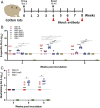A safe and highly efficacious measles virus-based vaccine expressing SARS-CoV-2 stabilized prefusion spike
- PMID: 33688034
- PMCID: PMC8000430
- DOI: 10.1073/pnas.2026153118
A safe and highly efficacious measles virus-based vaccine expressing SARS-CoV-2 stabilized prefusion spike
Abstract
The current pandemic of COVID-19 caused by severe acute respiratory syndrome coronavirus 2 (SARS-CoV-2) highlights an urgent need to develop a safe, efficacious, and durable vaccine. Using a measles virus (rMeV) vaccine strain as the backbone, we developed a series of recombinant attenuated vaccine candidates expressing various forms of the SARS-CoV-2 spike (S) protein and its receptor binding domain (RBD) and evaluated their efficacy in cotton rat, IFNAR-/-mice, IFNAR-/--hCD46 mice, and golden Syrian hamsters. We found that rMeV expressing stabilized prefusion S protein (rMeV-preS) was more potent in inducing SARS-CoV-2-specific neutralizing antibodies than rMeV expressing full-length S protein (rMeV-S), while the rMeVs expressing different lengths of RBD (rMeV-RBD) were the least potent. Animals immunized with rMeV-preS produced higher levels of neutralizing antibody than found in convalescent sera from COVID-19 patients and a strong Th1-biased T cell response. The rMeV-preS also provided complete protection of hamsters from challenge with SARS-CoV-2, preventing replication in lungs and nasal turbinates, body weight loss, cytokine storm, and lung pathology. These data demonstrate that rMeV-preS is a safe and highly efficacious vaccine candidate, supporting its further development as a SARS-CoV-2 vaccine.
Keywords: SARS-CoV-2 vaccine; measles virus vector; prefusion spike.
Copyright © 2021 the Author(s). Published by PNAS.
Conflict of interest statement
Competing interest statement: The Ohio State University has filed an invention report for the measles virus-based SARS-CoV-2 vaccine platform.
Figures









Similar articles
-
Recombinant measles virus expressing prefusion spike protein stabilized by six rather than two prolines is more efficacious against SARS-CoV-2 infection.J Med Virol. 2023 Apr;95(4):e28687. doi: 10.1002/jmv.28687. J Med Virol. 2023. PMID: 36941778
-
Measles Virus-Based Vaccine Expressing Membrane-Anchored Spike of SARS-CoV-2 Inducing Efficacious Systemic and Mucosal Humoral Immunity in Hamsters.Viruses. 2024 Apr 3;16(4):559. doi: 10.3390/v16040559. Viruses. 2024. PMID: 38675901 Free PMC article.
-
Intranasal measles virus- and mumps virus-based SARS-CoV-2 vaccine candidates prevent SARS-CoV-2 infection and transmission.Proc Natl Acad Sci U S A. 2025 Aug 12;122(32):e2506821122. doi: 10.1073/pnas.2506821122. Epub 2025 Aug 6. Proc Natl Acad Sci U S A. 2025. PMID: 40768351
-
Comparison of the immunogenicity & protective efficacy of various SARS-CoV-2 vaccine candidates in non-human primates.Indian J Med Res. 2021 Jan & Feb;153(1 & 2):93-114. doi: 10.4103/ijmr.IJMR_4431_20. Indian J Med Res. 2021. PMID: 33361645 Free PMC article.
-
Antibody tests for identification of current and past infection with SARS-CoV-2.Cochrane Database Syst Rev. 2022 Nov 17;11(11):CD013652. doi: 10.1002/14651858.CD013652.pub2. Cochrane Database Syst Rev. 2022. PMID: 36394900 Free PMC article.
Cited by
-
Oral Supplementation with AHCC®, a Standardized Extract of Cultured Lentinula edodes Mycelia, Enhances Host Resistance against SARS-CoV-2 Infection.Pathogens. 2023 Apr 3;12(4):554. doi: 10.3390/pathogens12040554. Pathogens. 2023. PMID: 37111440 Free PMC article.
-
A protective measles virus-derived vaccine inducing long-lasting immune responses against influenza A virus H7N9.NPJ Vaccines. 2023 Mar 24;8(1):46. doi: 10.1038/s41541-023-00643-9. NPJ Vaccines. 2023. PMID: 36964176 Free PMC article.
-
Indirect Dispersion of SARS-CoV-2 Live-Attenuated Vaccine and Its Contribution to Herd Immunity.Vaccines (Basel). 2023 Mar 14;11(3):655. doi: 10.3390/vaccines11030655. Vaccines (Basel). 2023. PMID: 36992239 Free PMC article. Review.
-
An adjuvanted subunit SARS-CoV-2 spike protein vaccine provides protection against Covid-19 infection and transmission.NPJ Vaccines. 2022 Feb 23;7(1):24. doi: 10.1038/s41541-022-00450-8. NPJ Vaccines. 2022. PMID: 35197485 Free PMC article.
-
Animal models for studying coronavirus infections and developing antiviral agents and vaccines.Antiviral Res. 2022 Jul;203:105345. doi: 10.1016/j.antiviral.2022.105345. Epub 2022 May 21. Antiviral Res. 2022. PMID: 35605699 Free PMC article. Review.
References
-
- Thanh Le T., et al. ., The COVID-19 vaccine development landscape. Nat. Rev. Drug Discov. 19, 305–306 (2020). - PubMed
Publication types
MeSH terms
Substances
Grants and funding
- R21 AI142256/AI/NIAID NIH HHS/United States
- R01 AI090060/AI/NIAID NIH HHS/United States
- R01 AI123661/AI/NIAID NIH HHS/United States
- R01 HL154001/HL/NHLBI NIH HHS/United States
- R56 AI090060/AI/NIAID NIH HHS/United States
- R01 AI150473/AI/NIAID NIH HHS/United States
- R01 AI137567/AI/NIAID NIH HHS/United States
- R01 AI130110/AI/NIAID NIH HHS/United States
- R01 AI112381/AI/NIAID NIH HHS/United States
- RM1 HG008935/HG/NHGRI NIH HHS/United States
- U19 AI142733/AI/NIAID NIH HHS/United States
- U54 CA260582/CA/NCI NIH HHS/United States
- R21 AI146690/AI/NIAID NIH HHS/United States
- R01 AI093848/AI/NIAID NIH HHS/United States
- R01 AI151175/AI/NIAID NIH HHS/United States
- R21 AI151230/AI/NIAID NIH HHS/United States
- U19AI42733/NH/NIH HHS/United States
- R01 AI101175/AI/NIAID NIH HHS/United States
- P01 AI112524/AI/NIAID NIH HHS/United States
LinkOut - more resources
Full Text Sources
Other Literature Sources
Medical
Molecular Biology Databases
Miscellaneous

